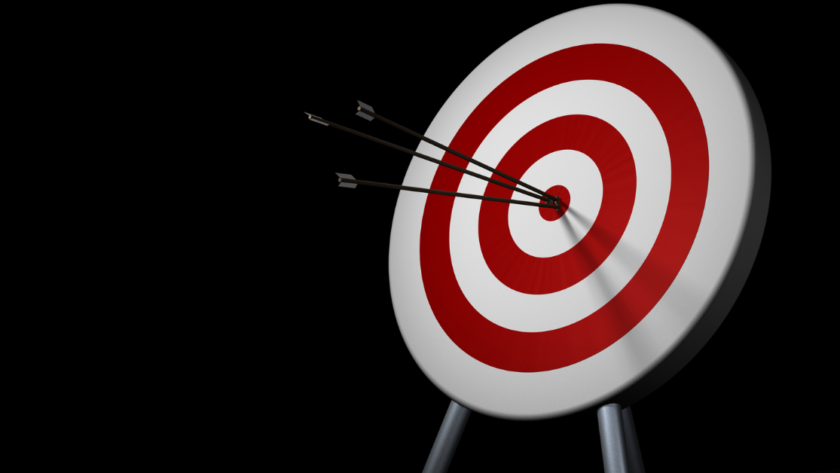As a new archer, I remember feeling overwhelmed by the large array of target options available. Choosing the right target isn’t about having something to shoot at – it’s a crucial step in developing proper technique and building confidence from the start.
The right target can make all the difference in your archery experience.
Foam Block Targets: The Unsung Heroes
When it comes to beginner-friendly targets, foam block targets are true standouts in the archery world. These unassuming rectangular blocks of layered foam pack a punch when it comes to benefits for new archers.
Foam block targets offer incredible versatility and durability, making them perfect for high-volume shooting sessions. The layered foam construction allows for easy arrow removal – a crucial feature when you’re just starting out.
There’s nothing more frustrating than struggling to pull out arrows after every shot, and foam blocks eliminate this issue.
One of the best features of foam block targets is their self-healing properties. When an arrow hits the target, the foam compresses.
Once you remove the arrow, the foam expands back to it’s original shape.
This means you can shoot the same spot repeatedly without creating large holes in your target.
For the best practice experience, look for foam block targets with many aiming points or printed target faces. This variety keeps your practice sessions interesting and helps you work on different aspects of your shooting technique.
Bag Targets: Portable Practice Companions
If you’re the type of archer who likes to practice in various locations, bag targets might become your new favorite. These lightweight targets are filled with synthetic fibers that effectively stop arrows while still allowing for easy removal.
Bag targets excel in portability. You can easily move them around your backyard, take them to a friend’s place, or even bring them along on camping trips.
They’re also great for high-volume shooting, making them ideal for those long practice sessions when you’re determined to perfect your form.
However, bag targets do have a few limitations. They’re not as weather-resistant as some other options, so you’ll need to bring them indoors or cover them when not in use.
They also tend to wear out faster than foam targets, especially if you’re using broadhead arrows.
To get the most out of your bag target, invest in a good target stand. This will help prolong the life of your target by keeping it off the ground and making it easier to position at the right height.
3D Targets: Stepping Up Your Game
While 3D animal targets might seem intimidating (and a bit pricey) for beginners, they can be an excellent investment if you’re planning to get into bowhunting or want to add some variety to your practice.
These lifelike targets offer a more realistic shooting experience, helping you learn proper shot placement and develop depth perception. They’re especially useful for field archery practice, where you’ll be shooting at varying distances and angles.
However, 3D targets do require more maintenance than their simpler counterparts. You’ll need to replace the target cores periodically, and they can be more challenging to transport because of their size and shape.
If you’re just starting out but want to try a 3D target, consider a smaller option like a rabbit or turkey. These are more affordable and easier to handle than larger targets like deer or bears.
Setting Up Your Practice Area
Now that we’ve covered the main types of targets, let’s talk about how to set up your practice area for most effectiveness and safety.
Choose a Safe Location
Safety should always be your top priority when practicing archery. Ensure you have a clear shooting lane with no risk of arrows going astray.
Always use a proper backstop behind your target to catch any missed shots.
This could be a large mound of dirt, a dedicated archery backstop, or even a thick layer of foam boards.
Set the Right Distance
As a beginner, start close to your target – around 10 yards is a good starting point. Gradually increase the distance as your skills improve.
This approach helps you build confidence and develop proper form before challenging yourself with longer distances.
Vary Your Practice
Don’t just shoot at the same spot every time. Use different aiming points or create games for yourself to keep things interesting.
This prevents your target from wearing out in one spot and helps improve your overall accuracy and adaptability.
Maintain Your Target
Regularly inspect your target for wear and tear. Replace or rotate it as needed to confirm consistent performance.
Proper maintenance will extend the life of your target and confirm you always have a reliable surface to shoot at.
Use the Right Arrows
Make sure you’re using field points for practice, not broadheads, unless your target is specifically designed for them. Broadheads can cause excessive damage to most targets and are more difficult to remove.
Common Pitfalls and How to Avoid Them
Even with the best targets, beginners can run into some common issues. Here’s how to sidestep them:
Overshot Targets
Don’t be tempted to keep shooting at a worn-out target. This can lead to pass-throughs and damaged arrows.
Replace or rotate your target when it starts showing significant wear.
Improper Arrow Removal
Always remove arrows carefully, pulling straight back from the target. Wiggling or twisting can damage both the arrow and the target.
If an arrow is difficult to remove, use an arrow puller tool to get a better grip.
Ignoring Safety
Never shoot at a target without a proper backstop, even if you think you’re accurate enough. A stray arrow can travel much farther than you might expect and pose a serious safety risk.
Neglecting Target Maintenance
Clean your target regularly and store it properly when not in use. For foam targets, you can use a stiff brush to remove dirt and debris.
Bag targets can often be fluffed up to redistribute the filling.
If you’re using an outdoor target, consider covering it or bringing it inside when not in use to protect it from the elements.
Adapting Your Target Practice
As you progress in your archery skills, you’ll want to adapt your target practice to continue challenging yourself. Here are some ideas:
Increase Distance
Gradually move further back from your target as your accuracy improves. This will help you develop better aim and learn to compensate for arrow drop over longer distances.
Add Movement
Once you’re comfortable with stationary targets, try shooting at swinging targets to simulate hunting scenarios or add an extra challenge to your practice. You can create a simple swinging target by hanging a bag target from a sturdy frame.
Experiment with Angles
Practice shooting from different positions, including kneeling and elevated positions. This will help you prepare for real-world scenarios, whether you’re interested in hunting or field archery competitions.
Introduce Time Pressure
Set a timer for your shots to simulate the pressure of competition or hunting situations. Start with a comfortable time limit and gradually reduce it as your skills improve.
Remember, consistent practice is key to improving in archery. Even a short practice session every day is better than marathon sessions once a week.
Try to establish a regular practice routine that fits your schedule.
From Basics to Mastery
Choosing the right target as a beginner is just the first step on your path to archery mastery. As you progress, you’ll find that your target needs evolve along with your skills.
You might start with a simple foam block target, move on to a 3D target for more realistic practice, and eventually set up a full field archery course in your backyard (if you’re lucky enough to have the space!).
The important thing is to keep challenging yourself and enjoying the process. Archery is a sport where there’s always room for improvement, no matter how good you get.
Practice Exercises
To help you make the most of your new target, try these exercises:
The Balloon Challenge
Attach small balloons to your target and try to pop them. This helps improve accuracy and provides instant feedback.
The satisfying pop of a balloon is also a great motivator!
The Playing Card Game
Pin playing cards to your target and try to hit specific cards. This is great for precision practice.
As you improve, try to hit specific parts of the cards, like cutting them in half or hitting only the red suits.
The Timed Round
Set a timer for one minute and see how many accurate shots you can make. This helps develop speed and accuracy under pressure.
As you improve, try to increase your shot count while maintaining accuracy.
The Distance Ladder
Start close to the target and take a step back after each successful shot. See how far back you can get while maintaining accuracy.
This exercise helps you understand how distance affects your shots and improves your ability to adjust for different ranges.
The Weak Side Challenge
If you normally shoot right-handed, try shooting left-handed (or vice versa). This improves overall body awareness and control.
It can also be a fun way to challenge yourself and add variety to your practice sessions.
Advanced Target Considerations
As you progress in your archery skills, you might want to consider some more advanced target options:
Multi-Spot Targets
These targets feature many small bullseyes on a single face. They’re great for practicing precision and are commonly used in indoor archery competitions.
Multi-spot targets allow you to shoot more arrows before needing to retrieve them, making your practice sessions more efficient.
NASP Targets
If you’re interested in participating in the National Archery in the Schools Program (NASP), you might want to practice with their official targets. These targets have specific scoring rings and are used in NASP competitions.
Olympic-Style Targets
For those interested in Olympic archery, practicing with official Olympic-style targets can help you get accustomed to the scoring system and target size used in these competitions.
Broadhead Targets
If you plan to hunt with broadhead arrows, you’ll need a target specifically designed to handle them. These targets are usually made of self-healing foam that can withstand the cutting edges of broadheads without excessive damage.
Target Maintenance and Longevity
To get the most out of your archery targets, proper maintenance is crucial. Here are some tips to extend the life of your targets:
Rotate Your Target
Regularly rotate your target to distribute wear evenly. This is especially important for block targets where you might tend to aim at the same spot repeatedly.
Use Arrow Lube
Applying arrow lube to your arrows can make them easier to remove from the target, reducing wear and tear on both the arrows and the target.
Store Properly
When not in use, store your targets in a cool, dry place. Exposure to extreme temperatures and moisture can degrade the target material over time.
Repair When Necessary
For foam targets, you can often use spray foam insulation to fill in worn areas. For bag targets, you might be able to add more filling if the target starts to lose it’s stopping power.
Know When to Replace
Even with proper care, all targets will eventually wear out. Be prepared to replace your target when it no longer stops arrows effectively or when arrow removal becomes difficult.
Safety Considerations
Safety should always be your top priority when practicing archery. Here are some key safety tips to keep in mind:
Always Use a Backstop
Even if you’re shooting at a large target, always have a backstop behind it to catch any stray arrows.
Inspect Your Equipment
Regularly check your bow, arrows, and target for any signs of damage or wear. Damaged equipment can be dangerous and affect your shooting accuracy.
Be Aware of Your Surroundings
Always be conscious of what’s beyond your target. Never shoot if there’s a chance an arrow could travel into an area where people or animals might be.
Use Proper Form
Good form improves your accuracy and helps prevent injuries. If you’re unsure about your form, consider taking a lesson from a certified instructor.
Never Dry Fire
Never release the bowstring without an arrow nocked. This can damage your bow and potentially cause injury.
Target Accessories
To enhance your target practice experience, consider these useful accessories:
Target Stand
A good target stand can make your practice sessions more convenient and help protect your target from ground moisture.
Arrow Puller
This simple tool can make arrow removal much easier, especially from dense foam targets.
Target Face Pins
These help secure paper targets to your block or bag target, making it easy to change out target faces.
Target Light
If you like to practice in low light conditions, a target light can illuminate your target without affecting your night vision.
Eco-Friendly Target Options
For environmentally conscious archers, there are several eco-friendly target options available:
Biodegradable Targets
Some manufacturers now offer targets made from biodegradable materials that break down naturally over time.
Recycled Material Targets
Look for targets made from recycled materials, such as those that use recycled plastic in their construction.
DIY Natural Targets
You can create your own targets using natural materials like straw bales or compacted cardboard. While these may not last as long as commercial targets, they’re inexpensive and environmentally friendly.
Target Customization
As you become more experienced, you might want to customize your targets to suit your specific needs:
Painted Targets
You can paint your own designs on block targets to create custom practice scenarios.
3D Target Modifications
Some archers change their 3D targets with extra scoring rings or vital area markers for more precise practice.
Interchangeable Target Cores
For 3D targets, look for options with replaceable cores. This allows you to replace only the most worn parts of the target, saving money in the long run.
Conclusion
Choosing the right archery target as a beginner is crucial for developing good habits and enjoying the sport. Whether you opt for a foam block, bag target, or 3D target, the key is to practice regularly and safely.
As you progress, don’t be afraid to try different types of targets to keep your practice sessions challenging and engaging.
Remember, archery is a pathway of continuous improvement. The right target will help you build skills, boost confidence, and most importantly, have fun along the way.
So grab your bow, set up your target, and let those arrows fly!
Key Takeaways:
- Foam block targets are ideal for beginners because of their durability and ease of arrow removal.
- Bag targets offer portability but need more protection from the elements.
- 3D targets provide realistic practice for hunting scenarios but are more expensive.
- Always prioritize safety with proper backstops and clear shooting lanes.
- Regular target maintenance extends lifespan and confirms consistent performance.
- Adapt your practice routine as your skills improve to continue challenging yourself.
People Also Asked
What is the best archery target for beginners?
Foam block targets are generally considered the best option for beginners because of their durability, ease of arrow removal, and affordability.
How far should a beginner archer stand from the target?
Most beginners should start at about 10 yards from the target and gradually increase the distance as their skills improve.
Can I use any arrows with my archery target?
Most practice targets are designed for field point arrows. Broadhead arrows require special targets to prevent excessive damage.
How often should I replace my archery target?
The lifespan of an archery target depends on it’s type, quality, and how often it’s used. Generally, with proper care, a good target can last several months to a year or more.
Are 3D targets worth it for beginners?
While 3D targets can be useful, they’re often more expensive and may be overwhelming for absolute beginners. They’re a great option once you’ve mastered the basics.
What’s the difference between a bag target and a foam block target?
Bag targets are filled with synthetic fibers and are more portable, while foam block targets are made of layered foam and tend to be more durable.
Can I make my own archery target?
Yes, you can make DIY targets using materials like compressed cardboard or straw bales, though these may not last as long as commercial targets.
How do I maintain my archery target?
Regular maintenance includes rotating the target, storing it properly when not in use, and repairing minor damage promptly.
What size archery target should I get?
For beginners, a target with a face size of at least 18 inches is recommended to provide a large enough area to aim at.
Can I use an indoor archery target outdoors?
While some indoor targets can be used outdoors, it’s best to choose a weather-resistant target specifically designed for outdoor use if you plan to leave it outside.



